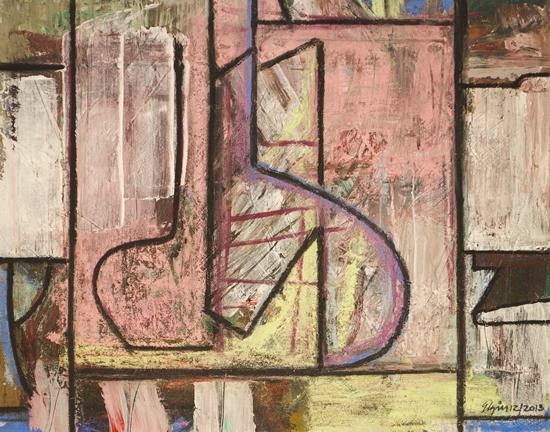 |
| Installation view featuring the painting titled Electric Soup at left
photo by Arthur Evans
|
 |
| Nicholas Krushenick - Battery Park, acrylic on canvas |
Krushenick is considered a pioneer of Pop abstraction, but is not easy to label: Wall text at the show explains that he "developed a distinct style that straddled the lines between Op, Pop, Abstract Expressionism, Minimalism and Color Field." Krushenick himself is then quoted as saying, "They don't really know where to place me, like I'm out in left field all by myself. And that's just where I want to stay." Rightly so, as that's exactly where a truly original painter belongs. Krushenick's work, being mostly hard-edged and flatly painted, would be easy to copy yet still appears innovative and unique.
 |
| Quick Red Fox, acrylic on canvas |
Though square and angular geometry is prevalent, Krushenick also used softer forms, curves, flowing lines, and shaped canvases. Four of the earlier pieces in the show, from about 1962-3, are painted freehand, so the black outlines are irregular, and they have a lot of painterly texture below the surface, a touch that disappeared in all the later works. The four also share an element of woven forms that do not reappear in the later work, except as flat grids. Among these is Quick Red Fox, the Tang's signature image for the show, and one that also uniquely features the color silver (shown above at left).
 |
| CBGB acrylic on canvas |
In the end, I found the work speaks with a clear voice across more than 50 years of densely packed history, and was a real pleasure just to hang out with. But you can still take this art seriously - I'd argue that one painting in the show, 1993's Space Map, is influenced by both Willem DeKooning's and Wassily Kandinsky's later works - and if you do take art seriously, or just want to enjoy a fun show, then don't miss this one - it passes both tests with flying colors.
 |
| Jeffrey Elgin -Thus Passed Some Days, mixed media on paper |
Elgin's earlier work evokes Cubism in both its rigorous fragmentation of shapes and its dark palette - but as the years go by, he lightens up, resulting in more penetrable and joyous work. I was amazed by Elgin's ability to invent new forms constantly, and to avoid the pitfalls of representational associations - though, when he does appear to have a "subject," such as a window view or a row of common objects, it still works. I liked the show so much, I bought a painting.
Jeffrey Elgin - Thus Passed Some Days: Twenty Years upon an Overgrown Path is accompanied by a nicely produced 20-page catalog, which is available free in the gallery; also, there will be an artist's talk there at 4 p.m. on Thursday, April 9. Please take note, the show ends on April 26.




















